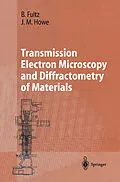This book teaches graduate students the concepts of trans- mission electron microscopy (TEM) and x-ray diffractometry (XRD) that are important for the characterization of materi- als. It emphasizes themes common to both techniques, such as scattering from atoms and the formation and analysis of dif- fraction patterns. It also describes unique aspects of each technique, especially imaging and spectroscopy in the TEM. The textbook thoroughly develops both introductory and ad- vanced-level material, using over 400 accompanying illustra- tions. Problems are provided at the end of each chapter to reinforce key concepts. Simple citatioins of rules are avoi- ded as much as possible, and both practical and theoretical issues are explained in detail. The book can be used as both an introductory and advanced-level graduate text since sec- tions/chapters are sorted according to difficulty and grou- ped for use in quarter and semester courses on TEM and XRD.
Klappentext
Aims and Scope of the Book This textbook was written for advanced un dergraduate students and beginning graduate students with backgrounds in physical science. Its goal is to acquaint them, as quickly as possible, with the central concepts and some details of transmission electron microscopy (TEM) and x-ray diffractometry (XRD) that are important for the characterization of materials. The topics in this book are developed to a level appropriate for most modern materials characterization research using TEM and XRD. There are, of course, many specialties that have attained a higher level of sophistication than presented here. The content of this book has been chosen in part to provide the background needed for a transition to these research specialties, or to other techniques such as neutron diffractometry. Although the book includes many practical details and examples, it does not cover some topics important for laboratory work. Perhaps the most obvious is the omission of specimen preparation methods for TEM. Beneath the details of principle and practice lies a larger goal of unifying the concepts common to both TEM and XRD. Coherence and wave interfer ence are conceptually similar for both x-ray waves and electron wavefunctions.
Inhalt
1. Diffraction and the X-Ray Powder Diffractometer.- 2. The TEM and its Optics.- 3. Scattering.- 4. Inelastic Electron Scattering and Spectroscopy.- 5. Diffraction from Crystals.- 6. Electron Diffraction and Crystallography.- 7. Diffraction Contrast in TEM Images.- 8. Diffraction Lineshapes.- 9. Patterson Functions and Diffuse Scattering.- 10. High-Resolution TEM Imaging.- 11. Dynamical Theory.- Further Reading.- References and Figures.- A. Appendix.- A.1 Indexed Powder Diffraction Patterns.- A.3 Mass Attenuation Coefficients for Characteristic K?? X-Rays.- A.3 Atomic Form Factors for X-Rays.- A.4 X-Ray Dispersion Corrections for Anomalous Scattering.- A.5 Atomic Form Factors for 200 keV Electrons and Procedure for Conversion to Other Voltages.- A.6 Indexed Single Crystal Diffraction Patterns: fcc, bcc, dc, hcp.- A.7 Stereographic Projections.- A.8 Examples of Fourier Transforms.- A.10 Numerical Approximation for the Voigt Function.- A.11 Debye-Waller Factor from Wave Amplitude.- A.12 Review of Dislocations.- A.13 TEM Laboratory Exercises.- A.13.1 Preliminary - JEOL 2000FX Daily Operation.- A.13.2 Preliminary - Philips 400T Daily Operation.- A.13.6 Laboratory 4 - Contrast Analysis of Defects.- A.14 Fundamental and Derived Constants.
